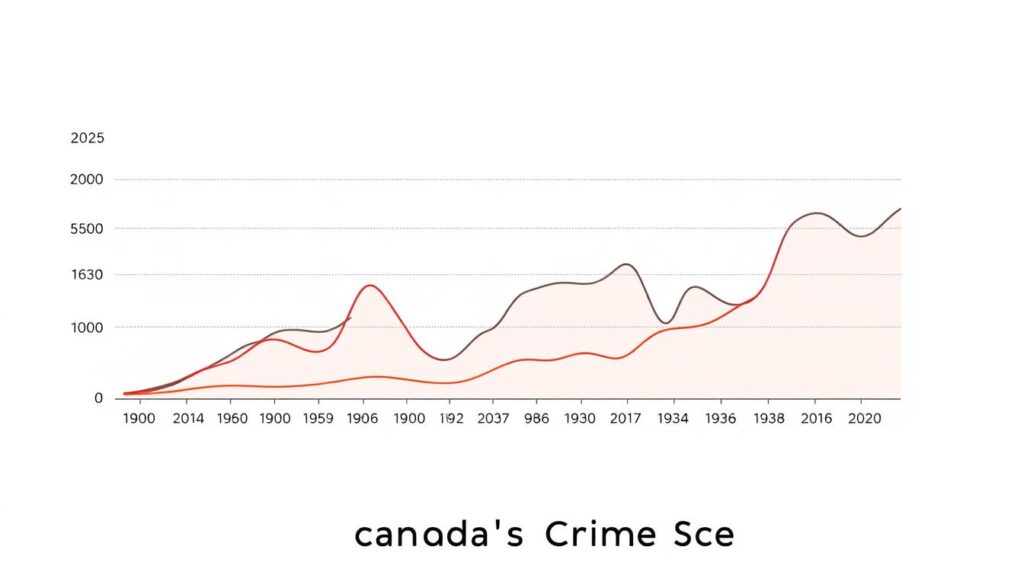Did you know one urban area accounts for nearly 15% of British Columbia’s serious criminal incidents? While Canada ranks among the safest G-20 nations, its safety landscape hides sharp contrasts. Police-reported offences climbed nationally by 3% in 2023, reaching 5,843 incidents per 100,000 residents. But these numbers don’t tell the full story.
Surrey, British Columbia, stands out with a Crime Index of 64.7 – the highest nationwide. Rapid population growth and organized crime have fueled this trend. Gang violence and drug trafficking dominate headlines, creating challenges for local law enforcement.
Urban safety varies wildly across provinces. A handful of municipalities absorb disproportionate shares of violent offences. This pattern raises critical questions about resource allocation and community support systems.
You’ll explore how economic shifts and infrastructure pressures impact regional crime rates. The analysis reveals why some areas struggle more than others, despite national stability. From police strategies to social programs, multiple factors shape these disparities.
Overview of Canada’s Crime Scene
Understanding national crime dynamics requires a closer look at recent statistical shifts. The Crime Severity Index (CSI) climbed 2% in 2023 – its third straight annual increase. This upward trend pushes the national crime rate to 5,843 incidents per 100,000 people, reflecting steady growth since 2020.

National Crime Statistics and Trends
While violent crime severity held stable, four categories spiked sharply:
- Vehicle theft (+24% since 2021)
- Break-ins (+18% in urban zones)
- Fraud (+46% over 10 years)
- Drug-related offences (+12% annually)
Statistics Canada attributes part of this rise to improved reporting systems. However, economic pressures and digital scams explain the fraud surge. Provinces with larger populations show more pronounced increases.
Urban Hotspots and Risk Factors
Metropolitan areas drive 68% of national crime rates. High-density regions face unique challenges:
- Transit hub theft clusters
- Property crime near commercial zones
- Organized crime networks in port cities
Police data reveals 22% of assaults occur in just 5% of neighborhoods. These zones often correlate with income gaps and limited social services. You’ll notice how localized issues skew national averages in the CSI.
How Crime Rankings are Determined in Canada
How do experts determine which areas are safer than others? Ranking systems rely on specialized tools that go beyond raw numbers. Three core metrics shape these evaluations: the Crime Severity Index, localized safety scores, and standardized population comparisons.

Understanding the Crime and Safety Indexes
Statistics Canada’s Crime Severity Index (CSI) revolutionized crime analysis by weighting offences based on their societal impact. A bank robbery counts more than a stolen bicycle under this system. The CSI combines:
| Index | Data Sources | Key Feature |
|---|---|---|
| Crime Severity | Police reports | Weights violent crimes 5x higher than theft |
| Safety Index | Resident surveys | Measures perceived security after dark |
This dual approach balances hard statistics with community experiences. As one analyst notes: “Numbers tell half the story – fear of crime alters daily routines just as much as actual incidents.”
Measuring Incidents per 100,000 People
Standardizing data prevents population size from distorting comparisons. A town of 10,000 with 50 thefts has a rate of 500 per 100,000 – five times higher than a city of 500,000 with 200 thefts (40 per 100,000). Key benefits include:
- Fair comparisons between large and small communities
- Clear identification of high-risk zones
- Accurate tracking of trends over time
These methods explain why some regions rank higher in crime severity analyses despite lower total incident counts. By focusing on rates and severity, rankings reveal true risk levels rather than just volume.
Insights into the most dangerous canadian city
Residents in Surrey face daily reminders of urban safety challenges. With 32,053 police service calls per 100,000 people last year, emergency responses shape neighborhood rhythms. A 14% jump in violent offences during early 2025 intensified concerns, particularly as robbery cases reached 85 incidents.

Real-Life Impact on Residents
Assault dominates local crime reports at 777 cases annually. Many families now avoid night walks, while businesses invest heavily in security systems. “You double-check door locks three times before bed,” shares a Whalley district resident. “It’s exhausting, but necessary.”
Though property crime dropped 15%, vehicle theft remains stubbornly high. Over 40% of households report knowing someone affected by break-ins. These incidents erode trust and strain community bonds.
Rapid population growth compounds these issues. New housing developments outpace infrastructure upgrades, creating pockets of vulnerability. Gang conflicts near transit hubs further disrupt daily life. As one city councilor notes: “Safety isn’t just statistics – it’s people altering their lives to manage risks.”
Local schools now include safety workshops in curricula. Public transit riders share real-time alerts through neighborhood apps. These adaptations reveal how crime reshapes routines in subtle yet pervasive ways.
Regional Trends in Canadian Urban Crime
Crime patterns across Canada reveal stark contrasts when mapped regionally. Western provinces consistently report higher urban risks, with specific hotspots driving provincial averages upward. Saskatchewan leads all regions with a Crime Severity Index of 146.8 – nearly triple the national rate.
Western Province Volatility
British Columbia’s interior cities show unpredictable shifts. Kelowna saw a 12% crime index jump last year, while Kamloops recorded higher raw rates despite smaller populations. Resource industry fluctuations create boom-bust cycles that strain community resources.
Alberta’s urban centers face similar pressures. Edmonton and Calgary account for 61% of the province’s violent crime reports. Drug trafficking corridors along Highway 1 exacerbate challenges in smaller municipalities.
Prairie Crime Dynamics
Manitoba and Saskatchewan struggle with concentrated gang activity. Winnipeg reports 38% of assaults linked to organized groups – three times the national average. Regina’s homicide rate remains 22% above Canada’s mean despite population growth slowing.
These regions share common stressors:
- Underfunded social programs in fast-growing cities
- Cross-border drug networks using prairie highways
- Economic disparities in Indigenous communities
As one RCMP analyst notes: “You can’t police your way out of systemic issues – these crime clusters reflect decades of uneven development.” Understanding these geographic patterns helps explain why safety experiences vary dramatically across provinces.
Comparing Violent Offences and Property Crimes
Property-related incidents affect seven times more households than violent acts across urban centers. This disparity shapes how communities allocate security budgets and design prevention programs. Let’s break down where these threats concentrate and how they differ in societal impact.

Violent Crime Rates and Statistics
Assault cases dominate violent offence reports nationwide. Surrey’s 777 annual assault files outpace other categories, while robbery incidents climbed to 85 in early 2025. Winnipeg’s homicide rate reached 5.04 per 100,000 residents last year – second highest among major cities.
Urban violence often clusters in specific zones. Thunder Bay leads in homicides, but smaller cities like Prince Albert show similar patterns. A police analyst notes: “These hotspots need tailored interventions – what works for gang violence won’t address domestic assaults.”
Property Crime Benchmarking
Lethbridge’s property crime rate towers at 5,521 incidents per 100,000 people – 119% above the national average. Compare this to Kelowna (4,778) and Regina (4,496). Common issues include:
- Vehicle theft in parking lots
- Break-ins near transit hubs
- Vandalism in underpatrolled areas
These crimes create widespread financial strain. Insurance claims for stolen vehicles alone cost Albertans $217 million last year. Yet public fear focuses more on violent offences, despite property crimes affecting far more households.
Factors Influencing Crime Severity in Canada
Crime patterns don’t form in isolation – they’re shaped by interconnected pressures affecting communities differently. Economic instability, population shifts, and policy gaps create environments where illegal activities thrive. You’ll find these elements interact in predictable ways across regions.

Socio-Economic and Demographic Challenges
Resource industry volatility leaves towns vulnerable. When oil prices drop 30% in six months, layoffs follow. Unemployment spikes correlate with 18% higher theft rates in affected areas within a year.
Urban centers face different stresses. Fast-growing cities like Kelowna see population jumps outpacing social services by 3:1 ratios. This gap leaves neighborhoods without youth programs or addiction support – key buffers against crime.
| Stress Factor | Crime Impact | High-Risk Zones |
|---|---|---|
| Housing Costs | 27% higher break-ins | Vancouver suburbs |
| Drug Networks | +41% gang activity | Port cities |
| Income Gaps | 2x assault rates | Prairie cities |
Law Enforcement and Policy Measures
Police strategies adapt to shifting threats. Calgary’s gang task force reduced firearm seizures by 14% through port monitoring. However, violent crime rates remain stubborn in areas with limited mental health resources.
Community programs show promise. Winnipeg’s outreach teams connect high-risk youth with job training, cutting neighborhood thefts by 22% in two years. As one policy advisor notes: “Prevention requires matching solutions to local realities – there’s no universal fix.”
Safety Measures and Community Responses
Proactive steps transform neighborhoods from vulnerable zones into resilient communities. Simple adjustments to daily habits and property setups slash opportunities for criminals. Combined efforts between residents and local authorities create layers of protection that deter theft and enhance safety.
Neighbourhood Watch and Community Policing
Solid deadbolts and motion-activated lights make homes less appealing targets. A Surrey police officer confirms: “Homes with visible security features experience 37% fewer break-in attempts.” Pair these with monitored parking areas to reduce vehicle-related incidents. Well-lit lots with surveillance cameras cut theft risks by half compared to unsecured spaces.
Effective community networks use:
- Shared messaging apps for real-time alerts
- Scheduled patrol walks during high-risk hours
- Monthly safety meetings with law enforcement
Group transportation plans in entertainment districts prove vital after dark. A Vancouver resident shares: “Our buddy system eliminated late-night harassment incidents in our building.” Storing valuables out of sight remains crucial – 68% of smash-and-grab thieves abandon targets without visible rewards.
| Prevention Strategy | Crime Reduction | Implementation Cost |
|---|---|---|
| Enhanced Lighting | 41% fewer assaults | Low |
| Neighbourhood Patrols | 29% less vandalism | Volunteer-based |
| Security Cameras | 55% drop in thefts | Moderate |
These layered approaches demonstrate how resident engagement strengthens security. When communities and police share information swiftly, problem areas get addressed before crises develop.
Future Trends and Prevention Strategies
Urban safety strategies face unprecedented challenges as technology and social shifts collide. Emerging tools must address both physical threats and digital vulnerabilities to keep pace with evolving risks. Three forces will dominate crime prevention efforts: smarter security systems, policy reforms, and adaptive community programs.
Innovations in Security and Surveillance
AI now analyzes surveillance footage in real time, flagging suspicious activity before incidents escalate. Vancouver transit authorities reduced assaults by 19% using these systems in 2024. “Machines spot patterns humans miss,” explains a cybersecurity specialist. Predictive policing algorithms map high-risk zones using historical data and weather patterns.
Digital fraud requires equally advanced countermeasures. Banks deploy behavior-tracking software that detects account takeovers within 8 seconds. Yet criminals adapt quickly – cryptocurrency scams rose 63% last year alone.
- Facial recognition at border crossings
- Drone patrols over remote infrastructure
- Encrypted community alert networks
Climate-related crimes present new challenges. Insurance analysts note a 27% rise in wildfire arson cases during drought years. Housing shortages in growing cities like Kelowna correlate with increased property disputes. Policy makers now weigh these factors when allocating security resources.
| Strategy | Impact | Adoption Rate |
|---|---|---|
| AI Surveillance | 22% faster response | 47% cities |
| Cyber Patrols | 58% fraud reduction | 29% agencies |
| Community Apps | 34% safer perception | 61% neighborhoods |
These advancements work best when paired with social support systems. Mental health crisis teams now accompany police on 38% of Winnipeg’s wellness checks. As one program director notes: “True security means addressing why crimes happen, not just reacting to them.”
Conclusion
Urban safety in Canada reveals a patchwork of risks and resilience. While national crime rates remain moderate overall, certain areas face concentrated challenges. Places like Surrey and Kelowna show how population surges and drug networks can strain community safety.
Contrasts emerge when comparing cities with different support systems. Quebec demonstrates how neighborhood partnerships and early intervention programs reduce offences. Meanwhile, Sudbury’s theft statistics highlight ongoing struggles with property crimes in changing economies.
You can enhance safety through awareness and action. Track local crime patterns using police-reported statistics. Support youth outreach initiatives and secure your property against common theft methods. Small steps create ripple effects across neighborhoods.
Ultimately, urban security depends on balancing enforcement with social investment. By understanding regional risks and sharing prevention strategies, people build stronger communities. Staying informed helps you navigate Canada’s evolving safety landscape with confidence.

